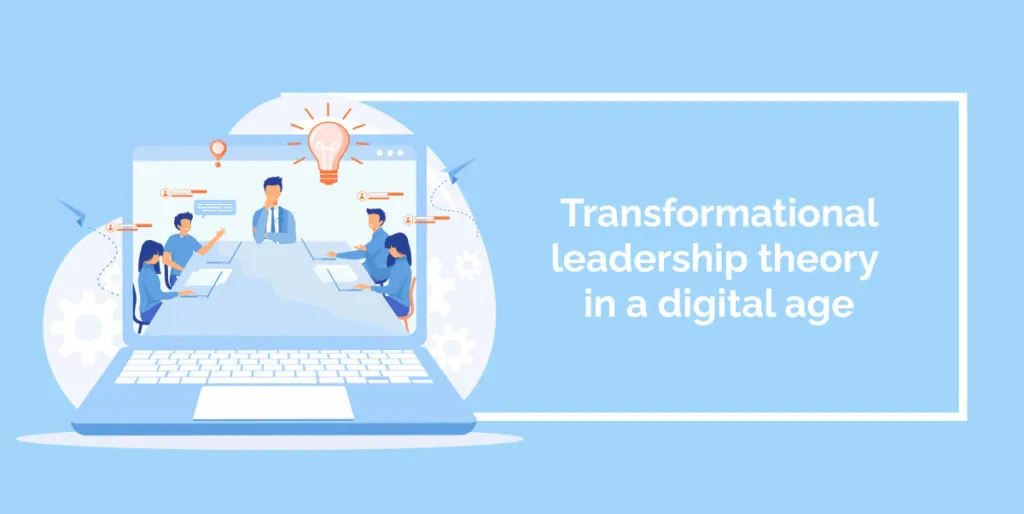
Transformational leadership theory is a thoroughly researched and extensively used theory of leadership. Since its inception in the 1970s, the value of transformational leadership has been proven in many sectors, and across the business world.
Whatever type of organization you are trying to lead, transformational leadership teaches valuable skills in empathy, communication, and employee engagement.
This article will give you a thorough grounding in transformational leadership with an emphasis on its implications for change management projects. It will:
- Define transformational leadership theory, including its meaning, benefits, and differences from other leadership styles
- Explain in more detail how transformational leadership is different from transactional leadership
- Examine how transformational leadership supports change management projects
- Show the value of transformational leadership for digital transformation.
With the right training, anyone can make transformational leadership part of their leadership vision. So, read on to find out how.
What is transformational leadership theory?

Transformational leadership theory is a leadership approach that focuses on inspiring and motivating individuals to achieve outcomes that go beyond expectations. Instead of relying on discipline and threats, transformational leaders employ inspiration and motivation to foster a sense of purpose and commitment among their followers.
The roots of this theory can be traced back to James Burns’ 1978 book Leadership, where the concept gained prominence.
Transformational leaders, as outlined in this theory, exhibit proactive qualities. They are clear in their communication about goals, leading from the front and actively coaching their team members. These leaders promote the development of their followers and take a genuine interest in their emotional well-being. Importantly, transformational leaders regard their employees as integral contributors to the organization’s success.
In the 1985 book Leadership and Performance Beyond Expectations, WM Bass characterized transformational leadership through four key dimensions:
- idealized influence: Leaders serve as role models and are admired by their followers
- inspirational motivation: The ability to inspire and motivate others towards shared goals
- intellectual stimulation: Encouraging creativity and innovation among followers
- individualized consideration: Demonstrating a personalized and supportive approach to each team member.
Together, these dimensions form the foundation of the transformational leadership theory, emphasizing the leader’s role in elevating followers to achieve exceptional outcomes.
The benefits of transformational leadership theory

Research into this leadership theory consistently demonstrates its profound positive impact on individual employees, teams, business units, and entire organizations.
Employees
For employees, transformational leadership theory fosters an environment where individuals are inspired and motivated to surpass their expected performance levels. By emphasizing a shared vision and purpose, these leaders contribute to higher levels of job satisfaction among employees.
The personalized and supportive approach of transformational leaders makes each team member feel valued and supported.
Teams
Teams under transformational leaders often show improved collaboration, creativity, and innovation. The shared vision and motivational tactics employed by these leaders contribute to a cohesive team dynamic, resulting in better problem-solving and increased productivity.
Organizational
At the organizational level, transformational leadership contributes to a culture of continuous improvement and adaptability.
The emphasis on clear communication, development, and a shared vision helps align all units toward common goals, fostering unity and resilience. Ultimately, the benefits of transformational leadership are multi-faceted, creating a ripple effect that positively influences both individual and collective outcomes within the organizational context.
In some cases, leaders can use aspects of transformational leadership to achieve the most negative goals. We can call these cases “pseudo-transformational leaders”.
Transformational leadership vs. other leadership styles

Transformational leadership is often compared to other leadership using the full-range leadership model. This model positions laissez-faire, transactional, and transformational leadership along a continuum.
Laissez-faire leadership reflects a hands-off approach, where leaders avoid responsibilities and allow employees considerable autonomy. In contrast, transactional leadership focuses on performance improvement through mechanisms like incentives and penalties. (We will say more about the difference between transformational and transactional leadership in the next section of this article). Transformational leadership, positioned at the highest level, entails leaders who are highly engaged and efficient, surpassing their counterparts.
We can also compare transformational leadership theory with other approaches that inspire followers to be their best selves. After all, many leaders turn to transformational leadership theory to give them a positive and proactive leadership strategy. But this is not their only option.
Other “positive” leadership styles have some characteristics in common with transformational leadership: such as servant leadership or charismatic leadership. Although charismatic leadership is sometimes used interchangeably with transformational leadership, each has distinct practices, priorities, and underlying theories.
Transactional vs. transformational leadership theory
The most important comparison is, however, between transformational leadership and transactional leadership. Transactional leadership is the default setting for many people, while they aspire to become transformational leaders. In this section, we’ll go a little deeper into the differences.
The distinction between these two styles was made long ago by scholars of transformational leadership theory – just like in James Burns’ book we mentioned above. However, it would be a mistake to label one as “good” and the other as “bad”. They are both useful in different situations.
The priorities of transactional leadership are like this:
- Focus: Short-term goals, centered on immediate productivity and performance
- Emphasis: “What gets done” rather than delving into the reasons behind the actions.
- Approach: Primarily concerned with maintaining the status quo, and adhering to established rules and criteria.
Whereas transformational leadership would look more like this:
- Focus: Long-term perspective, centered around innovation, progress, and change.
- Emphasis: It aims to understand and communicate “why it gets done” to inspire meaningful actions.
- Approach: Actively pursues change, identifies needed innovations, and fosters a culture of continual improvement.
While each style has its merits and drawbacks, they are more likely to thrive in different contexts.
Transactional leadership thrives in situations demanding immediate results, crisis management, and adherence to established rules. During crises, the focus on maintaining business continuity aligns with the transactional approach. On the other hand, transformational leadership shines in fostering lasting change, cultivating organizational culture, and pursuing long-term goals.
Some researchers have spent a lot of time thinking about the differences between transactional and transformational leadership. If you’d like to know more, take a look at the 2002 book Developing potential across a full range of leaderships.
Using transformational leadership theory for organizational change
Transformational leadership theory supports organizational change very effectively. Major transformational leadership examples often illustrate major changes in old organizations. Wider research shows a demonstrable link between transformational leadership and change effectiveness.

Some of the key functions of transformational leadership for organizational change are the following:
- Transformational leaders excel in fostering emotional well-being and resilience. They employ active listening, thoughtful reflection, and effective communication to address and mitigate resistance. Their sensitivity and responsiveness prove invaluable in processes that may be discouraging or disheartening, ensuring a more positive and adaptive organizational response to change.
- Furthermore, effective use of transformational leadership theory often supports trust-building among employees. Leaders who instill trust cultivate a willingness among employees to embrace vulnerability and uncertainty associated with change. This trust stimulates commitment and positivity about change – in place of the instinctive fear and vulnerability.
- As a result of these other strengths, transformational leaders facilitate deep engagement with change processes. forging stronger connections between individuals and their work. This heightened awareness, driven by the leader’s influence, significantly shapes employee responses to change and enhances their willingness to actively participate in the transformative journey.
Transformational leadership theory does not offer a strict template for the change process. All the same, it creates a positive structure in which change can happen. Where transactional leadership might rely on rewards and punishments, transformational leadership’s emphasis on emotional engagement aligns better with the complexities and uncertainties inherent in change.
Transformational leadership theory in a digital age

In 2024, digital transformation continues to be a high priority for many leaders. Transformational leadership can help with these digital efforts. Managers can use the change leadership qualities we have already outlined, with other practices tailored to the specific demands of digital change management.
Here are four ways that transformational leadership theory can support digital transformation efforts.
Resolving Uncertainty
In the intricate landscape of a digital system, uncertainties loom large, manifesting as a lack of training and a clouded vision of the future. Here, the transformative power of a leader’s effective communication skills comes to the forefront, acting as a beacon to navigate through uncertainties.
A transformational leader, with their articulate and compelling communication style, sheds light on the challenges ahead. In doing so, they provide a clear vision for the future – in all its details.
Building proactive employee engagement
The implementation of substantial changes, such as the integration of ERP systems, introduces the challenge of garnering collective attention and enthusiasm.
Transformational leadership can cultivate highly proactive employee engagement. By fostering an environment where employees feel heard, valued, and connected to the purpose of change, transformational leaders bridge the gap between uncertainty and commitment, ensuring a more seamless transition to new paradigms.
Enhancing agility
Agile leadership is an important approach in digital projects.
Often, the problems with a digital solution only become clear at an implementation stage. Then, the scope may change, the nature of the implementation might alter, and employees must come along for the ride.
Agile leaders can handle the fast-paced changes in digital transformation. And when they take on the lessons of transformational leadership, they stand a much higher chance of keeping their teams motivated.
Research in Journal of the Knowledge Economy in 2023 has shown a clear link between the use of transformational leadership, organizational agility, and the success of digital transformation projects.
Achievement beyond expectations
Transformational leaders don’t merely settle for conventional goals; they aspire to achieve beyond expectations.
Through a culture of experimentation, transformational leaders can uncover latent features, functions, and capabilities in their software roll-outs. The era of artificial intelligence is an especially valuable moment. A supportive shadow AI policy, for example, gives employees the opportunity to suggest innovative ideas that could change working practices across the organization.
Transformational leadership is, then, a great way to ensure that your projects comes to a productive outcome.
Transformational leaders: bridging the gap in every project
Transformational leadership theory is not new, but it holds a lot of valuable lessons for the leaders of today and tomorrow. Indeed, 2023 research into leadership models shows that the transformational style still gives companies an important competitive edge.
How is transformational leadership staying relevant? It’s certainly not because the challenges are staying the same!
As the world moves from crises to crises, and employees are increasingly on the receiving end, a leader who can genuinely bridge the gap with their employees can make the biggest difference. McKinsey research predicted in 2023 that future success will be based on “a more open, collaborative, and emergent way of working”.
This is an exciting vision. But it could well be the humanity of transformational leadership – and not the subservient compliance of their staff – that makes the difference between growth and stagnation.
WalkMe Team
WalkMe spearheaded the Digital Adoption Platform (DAP) for associations to use the maximum capacity of their advanced resources. Utilizing man-made consciousness, AI, and context-oriented direction, WalkMe adds a powerful UI layer to raise the computerized proficiency, everything being equal.



